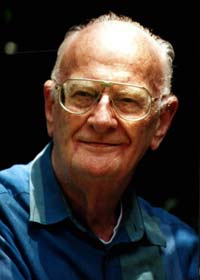Arthur C Clarke: The man who saw tomorrow
19 March 2008
One of the greatest minds of our generation passesd away early this morning. Sir Arthur Charles Clarke died in Sri Lanka at the age of 90. A brief profile of his extraordinary life. By Sourya Biswas
 "The truth, as always, will be far stranger."- Arthur C Clarke.
"The truth, as always, will be far stranger."- Arthur C Clarke.
If any man can be said to have seen tomorrow, it would be Sir Arthur Charles Clarke. One of the greatest scientific minds of our generation, who perhaps did more than anyone else in bringing science from the hallowed pages of scientific journals to everyday reading for ordinary people, died today in Sri Lanka at the ripe old age of 90. He had been living in Sri Lanka for the last 52 years.
Although many would associate him as the author of Stanley Kubrick's landmark film, 2001: A Space Odyssey, his greatest achievement, perhaps, lay in predicting future advances in human civilization. In this regard, he was the first to conceptualise a worldwide communication grid made up of artificial satellites hovering above the earth.
As a result, the geostationary orbit where satellites stay at a constant position over the earth's surface is also called Clarke Orbit or Clarke Belt in his honour. Of course, Clarke might have disagreed with the mention of earth here, as in his opinion, "How inappropriate to call this planet Earth, when clearly it is Ocean."
A brief history of Clarke's life would be incomplete without a mention of his immense contributions in the world of science fiction. Science fiction in Clarke's work had its foundation in the basic tenets of science, even as it soared beyond the limits of human imagination.
His close friendship with another literary luminary, ''the father of robotics'', Isaac Asimov, is well-documented. In fact, they had an unwritten agreement where Asimov was required to insist that Clarke was the best science fiction writer in the world (reserving second best for himself), while Clarke was required to insist that Asimov was the best science writer in the world (reserving second best for himself). These two, along with Robert Heinlen, were considered the ''big three'' among science-fiction writers and contributed immensely to popularize science amongst the non-scientific masses.
